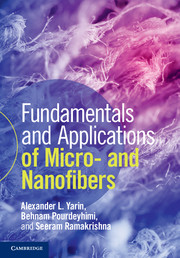Book contents
- Frontmatter
- Contents
- Preface
- 1 Introduction
- 2 Polymer physics and rheology
- 3 General quasi-one-dimensional equations of dynamics of free liquid jets, capillary and bending instability
- 4 Melt- and solution blowing
- 5 Electrospinning of micro- and nanofibers
- 6 Additional methods and materials used to form micro- and nanofibers
- 7 Tensile properties of micro- and nanofibers
- 8 Post-processing
- 9 Applications of micro- and nanofibers
- 10 Military applications of micro- and nanofibers
- 11 Applications of micro- and nanofibers, and micro- and nanoparticles: healthcare, nutrition, drug delivery and personal care
- Subject Index
- References
4 - Melt- and solution blowing
Published online by Cambridge University Press: 05 June 2014
- Frontmatter
- Contents
- Preface
- 1 Introduction
- 2 Polymer physics and rheology
- 3 General quasi-one-dimensional equations of dynamics of free liquid jets, capillary and bending instability
- 4 Melt- and solution blowing
- 5 Electrospinning of micro- and nanofibers
- 6 Additional methods and materials used to form micro- and nanofibers
- 7 Tensile properties of micro- and nanofibers
- 8 Post-processing
- 9 Applications of micro- and nanofibers
- 10 Military applications of micro- and nanofibers
- 11 Applications of micro- and nanofibers, and micro- and nanoparticles: healthcare, nutrition, drug delivery and personal care
- Subject Index
- References
Summary
This chapter describes the machinery, mechanism and significant experimental and theoretical aspects of melt- and solution blowing. Meltblowing is a popular method of producing polymer micro- and nanofibers en masse in the form of nonwovens via aerodynamic blowing of polymer melt jets (Section 4.1). Its physical aspects were revisited recently. The process involves a complex interplay of the aerodynamics of turbulent gas jets with strong elongational flows of polymer melts, only recently uncovered and explained.
The role of turbulent pulsations (produced by turbulent eddies in the gas jet) in meltblowing is discussed first in Section 4.2 in the framework of a model experimental situation where solid flexible sewing threadlines are used to probe a parallel high-speed gas jet. After that, in Section 4.3, the dynamics of bending and flapping of flexible threadlines in a gas jet is considered. In Section 4.4 the aerodynamically driven stretching of a straight polymer jet is considered. In Section 4.5 it is shown how a severe bending instability leading to strong stretching and thinning of polymer jets can arise. This is done in the framework of a linearized version of the governing equations in the case of small bending perturbations of a single threadline or polymer jet in meltblowing. Then, in Section 4.6 the fully nonlinear case of large-amplitude planar bending perturbations of a single polymer jet is discussed. Both isothermal and non-isothermal cases are considered. In particular, it is shown how the cooling of the surrounding gas jet results in cooling of the polymer jet inside, and in the arrest of the bending perturbation growth due to melt solidification. Section 4.7 is devoted to predictions of three-dimensional configurations of polymer jets in meltblowing from die exit to deposition screen. Not only a single polymer jet, but multiple polymer jets are modeled simultaneously, as well as deposition on a screen moving normally to the principal jet direction being accounted for. The results include prediction of the fiber deposition patterns in lay-down and fiber-size distributions in the resulting nonwovens. The angular distributions in lay-down nonwovens are also predicted. Comparisons with the experimental data suggest that the model captures main trends rather accurately.
- Type
- Chapter
- Information
- Fundamentals and Applications of Micro- and Nanofibers , pp. 89 - 178Publisher: Cambridge University PressPrint publication year: 2014



